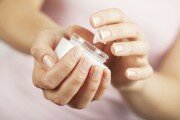Psoriasis Treatments: Prevent Dry, Itchy Flare-ups With Borage Oil
Chronic skin problems, such as eczema and psoriasis, often fail to respond to conventional treatments, which can mean years of misery and embarrassment for sufferers.
However, the good news is that this needn’t be the case any longer thanks to a remarkable natural remedy. Over recent years evidence has been steadily growing regarding the amazing benefits of borage seed oil.
Indeed, HSI Panellists believe that the research findings on borage oil are so impressive that they simply can’t be ignored any longer. That’s why we’re bringing you this report so you can benefit from borage seed oil’s therapeutic properties. Not only has it been found to help treat skin disorders but it can also provide effective relief from inflammatory conditions like rheumatoid arthritis.
Borage oil is an even richer source of GLA than evening primrose oil
You’ve probably heard of evening primrose oil. It gained popularity in the 1980s as a treatment for a number of health conditions, including premenstrual syndrome, multiple sclerosis and skin complaints. However, what you may not be aware of is that gamma linolenic acid (GLA) – the active component in evening primrose – is responsible for its effectiveness.
Since then an even richer source of GLA has been identified in borage oil, derived from the borage (Borago officinalis) plant – a wild flower that grows throughout Europe, America and North Africa.
Also known as the starflower because of its bright blue star-shaped flowers, the plant is harvested for its therapeutic seeds. They contain one of the richest sources of gamma linolenic acid (GLA) – a vital health-giving fatty acid – known to man. The GLA content of borage oil varies between 20-26 per cent. It is an essential fatty acid that is converted in your body to a hormone-like substance called prostaglandin E1 (PGE1).
Prostaglandin E1 has anti-inflammatory properties and may also act as a blood thinner and blood vessel dilator. As a result, it is a useful treatment for rheumatoid arthritis (painful joints benefit from the anti-inflammatory properties of increased blood flow), Raynaud’s disease (restricted circulation in the extremities), high cholesterol and atherosclerosis.
A deficiency of GLA has been detected in sufferers of skin disorders
GLA is produced in your body from linoleic acid, another essential fatty acid, which is found in many foods – for example, nuts, seeds and most unrefined vegetable oils. In a healthy person, linoleic acid is converted into GLA by an enzyme called delta-6-desaturase (D6D). In turn, GLA is converted into prostaglandin E1.
However, certain factors can interfere with the activity of delta-6-desaturase, resulting in a deficiency of GLA and therefore the beneficial prostaglandins. These include the consumption of saturated and hydrogenated fats (found in margarine, pastry and fried foods) or a lack of vitamin C, magnesium, zinc, and B vitamins.
It has been observed that people with skin disorders, such as eczema and psoriasis, have an increased level of linoleic acid with a simultaneous decrease in GLA. This suggests that something is blocking the conversion process (that is linolenic acid, to GLA to PGE1).
The outcome is a decrease in PGE1, which is associated with the typical symptoms of dry skin and trans-epidermal water-loss commonly seen in people with these skin disorders. By supplementing the diet with a source of preformed GLA from borage oil or applying borage oil topically to the skin, even serious skin problems have been found to improve.
Borage oil can relieve irritated skin in just under two weeks
In preliminary trials, borage oil has proved effective when used to treat people with eczema. Doctors report a reduction in skin inflammation, dryness, scaliness and itching.
In another preliminary study involving a group of babies with infantile seborrhoeic dermatitis (a condition characterised by itching, burning, scaly skin), 0.5ml of borage oil was applied to the nappy region twice a day.
After ten to twelve days, all skin lesions were healed, even in the areas not treated with borage oil.
Furthermore, applying the oil topically two to three times a week prevented the skin condition from recurring. There were no relapses after the oil was discontinued.
In a study that looked at the effectiveness of borage oil skin cream on dry or damaged skin, results showed that there was a significant improvement in the health and appearance of skin tissue.
The 20 participants who took part in the study applied the cream over a 14-day period. Skin moisture and smoothness were restored and the researchers concluded that borage oil plays an important role in re-establishing the intracellular moisture barrier of dry or damaged skin in adults.
What To Take For Best Results
Borage oil for external use is now available in the form of two body lotions: Borage Therapy Adult Formula and Borage Therapy Paediatric Formula for children, teens and young adults.
Borage Therapy Formulas are recommended for the treatment of most skin disorders including dry skin, eczema and psoriasis. In addition, borage oil capsules may be taken internally. Borage Therapy Hand Creams are also available. Borage Therapy Formulas should be applied three times a day to problem areas and are safe to use on a long-term basis. Results are normally seen within at least six weeks.
Related Reading:
Psoriasis: Natural Remedies Can Put A Stop To Maddening Itching And Persistent Pain
Psoriasis: Find Relief With An Ointment From The ‘Sausage Tree’
Did you find this information useful?
Then why not get more expert health recommendations just like this delivered direct to your inbox?
"It is truly refreshing to read a newsletter on the topic of alternative medicine which is scientifically based and reviewed by professionals..." - Robert Sinott
We respect your privacy and will never share your details with anyone else.
Sources:
1. Melnick, B and Plewig, G. Atopic dermatitis and disturbances in essential fatty acid and prostaglandin E metabolism. J.Amer. Acad. Dermatol. 1991;25:859
2. Bahiner, F A and Schafer, J. Treatment of atopic dermatitis with borage oil (Glandol) – A time series analysis study. Aktuel. Dermatol 1992;18:385
3. Diezel W E, Schulz, E, Skanks, M and Heise H. Plant oils: Topical application and anti-inflammatory effects (croton oil test). Dermatol. Monatsschr. 1993;179:173
4. Elias, P. as quoted in R L Goldberg. The Compounder’s Corner, Exotic Claims. Drug and Cosmetic ind. 1993 p. 40
5. Landi G. Oral administration of borage oil in atopic dermatitis. J Appl Cosmetology 1993;11:115-20
6. Tolleson A, Frithz A. Borage oil, an effective new treatment for infantile seborrhoeic dermatitis. Br J Dermatol 1993;25:95
7. Nissen, H P, Blitz H, and Muggli R. The effects of gamma
linolenic acid on skin smoothness, humidity and TEWL – A clinical study. Inform 1995;6;4:5 19










